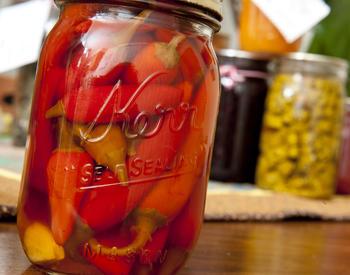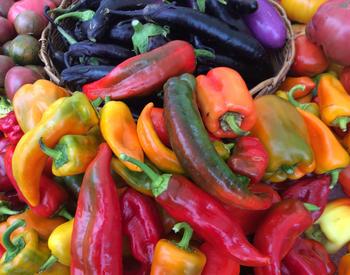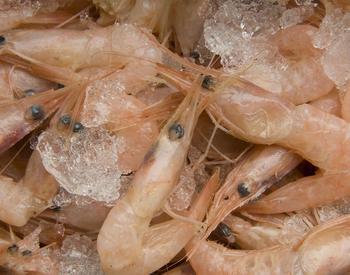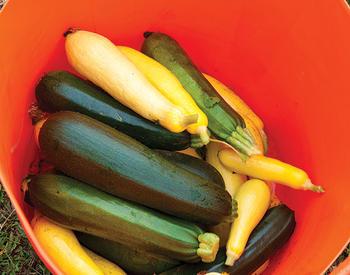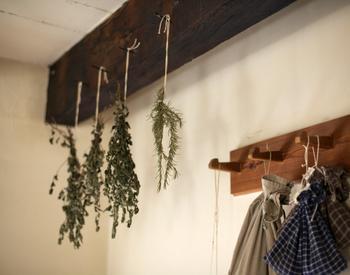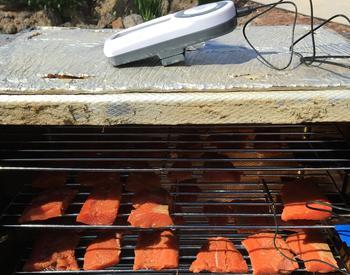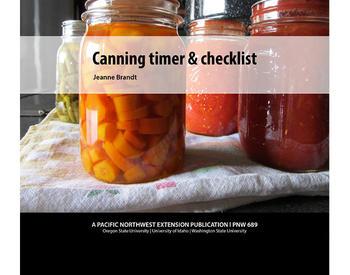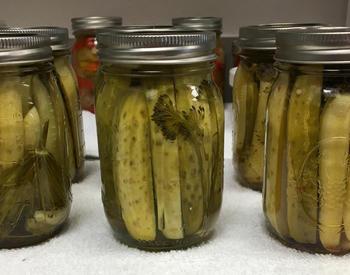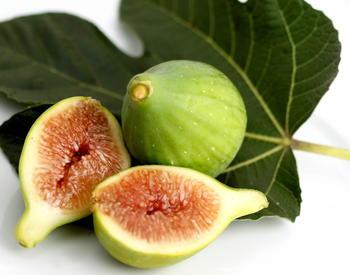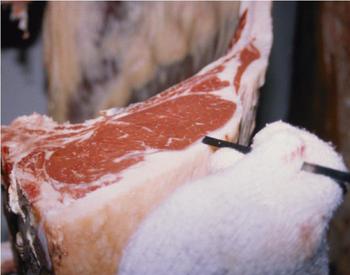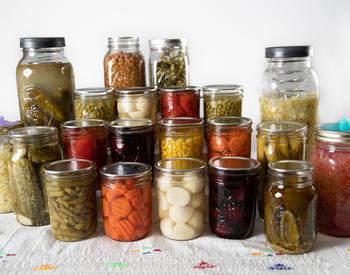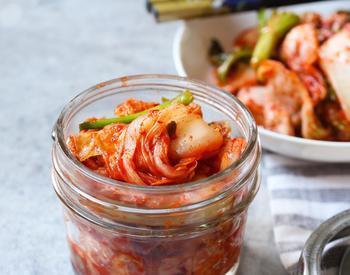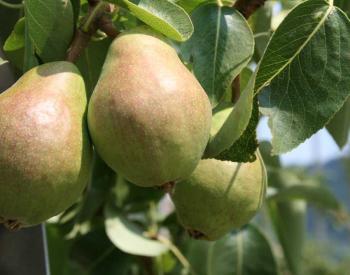Download this publication as a PDF
Many varieties of peaches are grown in Oregon. These fall into two general types: freestone (flesh readily separates from the pit) and clingstone (flesh clings tightly to the pit). Most people prefer to preserve freestone varieties.
Good varieties for canning include Veteran, Early Elberta, Elberta, Rochester, Hale, Alamar, Redglobe, Redhaven, and Sun Crest.
SAFETY ALERT: Use only yellow-fleshed peaches for canning. Because the pH is higher in white-fleshed peaches, they cannot be safely canned but can be frozen or dried.
Select peaches that are fairly firm. The skin color between the red areas should be yellow or creamy. Avoid hard peaches that have a distinct green color. These are immature and probably will not ripen satisfactorily. They will be hard to peel and the pits will cling even when ripe. Also, avoid overripe peaches and those with large bruises or signs of decay.
It takes about 2–3 pounds of peaches to fill a quart jar. A bushel weighs about 48 pounds and yields about 18–24 quarts of fruit. A lug yields 8–12 quarts of fruit. Peaches may be canned, frozen, dried, pickled, and made into jams and preserves.
Canning
Peaches must be processed in a boiling water canner. Ask your county Extension office for time adjustments if you live above 1,000 feet.
Cut peaches in half and remove pits. Slice, if desired. To prevent darkening during preparation, put the cut fruit into water containing 1 teaspoon ascorbic acid powder per gallon of water. Or, crush and dissolve six 500‑milligram vitamin C tablets per gallon of water. Drain.
Peaches may be canned in sugar syrup, juice or water. Suitable juices are apple, orange and pineapple.
Peaches canned with syrup will hold their shape better. For a 9‑pint load, use the following proportions.
Type of syrup
Cups of water
Cups of sugar
Very light
6 ½
¾
Light
5 ¾
1 ½
Medium
5 ¼
2 ¼
Heavy
5
3 ¼
Use either the hot or raw pack method:
Hot pack
In a large saucepan, place drained fruit in sugar syrup, water or juice and bring to a boil. Fill jars with hot fruit and cooking liquid, leaving ½-inch headspace. Place halves in layers, cut side down. Adjust lids and process in boiling water canner: pints for 20 minutes; quarts, 25 minutes.*
Raw pack
Fill jars with raw fruit, cut side down, and add hot water, juice or syrup, leaving ½-inch headspace. Adjust lids and process in a boiling water canner: pints for 25 minutes; quarts, 30 minutes. After processing, take canner off heat. Remove lid and wait 5 minutes before removing jars.* Note: Raw pack peaches may be poorer quality.
*After processing, take canner off heat. Remove lid and wait 5 minutes before removing jars.
Freezing
Wash peaches and remove skins and pits. Slice, if desired. Freeze in sugar syrup (see canning directions), in dry sugar (1 cup sugar for each 2–3 pounds of fruit) or in water or juice. Orange juice and pineapple juice work well because their high content of ascorbic acid helps prevent darkening.
Because peaches tend to turn brown, add ½ teaspoon ascorbic acid in powdered or crystal form to each 4 cups of water used in making the syrup. For sugar pack, dissolve the ascorbic acid in a little water and sprinkle over fruit before adding the sugar. When using commercial anti‑darkening mixtures, follow the directions of the manufacturer.
Pack peaches in moisture/vapor‑resistant freezer containers and add cooled syrup or juice, leaving ½- to 1-inch headspace.
Place a piece of crumbled plastic wrap on top of the fruit to hold it under the liquid. Seal and store at 0°F. for best quality.
Frozen peaches should be served with ice crystals still in them. Completely thawed peaches brown quickly.
Drying
Wash peaches and remove skins. Cut in half and remove pits. Cut in quarters or slices. To prevent browning, coat with an ascorbic acid solution (2½ teaspoons ascorbic acid crystals to each cup of water).
Drain well and spread in thin layer on drying trays. Dry until pliable and leathery in the sun or in an oven or dehydrator at 140°F.
Dried peaches may be eaten as snacks. After reconstituting, they can be used in breads, chutney, cobbler, cookies, dumplings, granola or pies.
Pickling
Peaches can be successfully pickled or made into fruit chutney. Select firm, ripe peaches for pickling.
Peach Pickles
Yield: Approximately 3 quarts.
- 8 lbs. peeled peaches, small- to medium-sized
- 4 sticks cinnamon
- 2 tablespoons whole cloves, crushed
- 1 tablespoon ground ginger or 1 tablespoon grated fresh ginger
- 6 cups sugar
- 1 quart vinegar
Wash and peel peaches. Treat to prevent darkening as outlined above for canning. Tie spices in a cheesecloth bag. Combine sugar, vinegar and spice bag in a large pan; bring to a boil and boil 5 minutes. Drain peaches in the boiling syrup until they can be pierced with a fork but not soft. Remove from heat and allow peaches to sit in pickling liquid overnight in the refrigerator to plump. Bring mixture to a boil. Remove spice bag. Pack hot peaches into hot jars. Ladle hot liquids over peaches leaving ¼-inch headspace. Remove air bubbles. Adjust lids and process in a boiling water canner for 20 minutes for both pints and quarts. After processing, take canner off heat. Remove lid and wait 5 minutes before removing jars.
Source: Ball Blue Book
Jams, jellies and preserves
Because peaches contain little natural pectin, it is best to use commercial pectin when making jelled products. Follow tested recipes provided by the manufacturer.
Canning
Peach Preserves
Yield: Approximately 9 half-pints.
- 4 cups peeled, sliced, pitted peaches (about 4 pounds)
- 1 package powdered commercial pectin
- 2 tablespoons lemon juice
- 7 cups sugar
Combine peaches, pectin and lemon juice in a large pan. Bring to a boil, stirring constantly. Add sugar. Return to a full rolling boil and boil 1 minute stirring constantly. Remove from heat. Skim foam, ladle into hot ½-pint canning jars. Adjust lids and process 10 minutes in a boiling water canner. After processing, take canner off heat. Remove lid. Wait 5 minutes before removing jars.
Source: Ball Blue Book
Peach Chutney
Yield: Approximately 7 pints
- 4 quarts finely chopped, peeled, pitted peaches (about 20 medium)
- 1 cup raisins
- 1 cup chopped onion (1 medium)
- 2-3 cups brown sugar
- ¼ cup mustard seed
- 2 tablespoons ginger
- 2 teaspoons salt
- 1 clove garlic, minced (optional)
- 1 hot red pepper, finely chopped
- 5 cups vinegar (5% acidity)
Combine all ingredients in a large pan. Cook slowly until thick (about 40 minutes). Stir frequently to prevent sticking. Ladle hot chutney into hot jars, leaving ¼-inch headspace. Adjust lids and process 10 minutes in a boiling water canner. After processing, take canner off heat. Remove lid. Wait 5 minutes before removing jars.
Source: Ball Blue Book
Note: For a milder chutney, remove seeds from the hot peppers. (Use rubber gloves to prevent burning hands).
Peach Pie Filling
Instructions are included in SP 50-616 Fruit Pie Fillings available at your local Extension office.
Source: OSU Master Food Preserver Program
2021 Oregon State University. OSU Extension Service cooperating. OSU Extension Service offers educational programs, activities and materials without discrimination based on race, color, religion, sex, sexual orientation, national origin, age, marital status, disability, or disabled veteran or Vietnam-era veteran status. OSU Extension Service is an Equal Opportunity Employer.
